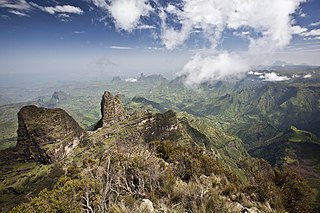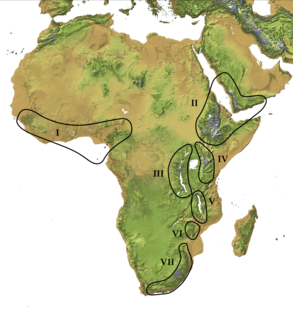
Yemen is located in Southwest Asia, at the southern tip of the Arabian Peninsula, between Oman and Saudi Arabia. It is situated at the entrance to the Bab-el-Mandeb Strait, which links the Red Sea to the Indian Ocean and is one of the most active and strategic shipping lanes in the world. Yemen has an area of 527,970 square kilometres (203,850 sq mi), including the islands of Perim at the southern end of the Red Sea and Socotra at the entrance to the Gulf of Aden. Yemen's land boundaries total 1,746 kilometres (1,085 mi). Yemen borders Saudi Arabia to the north and Oman to the northeast. Through the Socotra island, Yemen also shares borders with the Guardafui Channel and the Somali Sea.
The Global 200 is the list of ecoregions identified by WWF, the global conservation organization, as priorities for conservation. According to WWF, an ecoregion is defined as a "relatively large unit of land or water containing a characteristic set of natural communities that share a large majority of their species dynamics, and environmental conditions". So, for example, based on their levels of endemism, Madagascar gets multiple listings, ancient Lake Baikal gets one, and the North American Great Lakes get none.

The Afrotropical realm is one of Earth's eight biogeographic realms. It includes Africa south of the Sahara Desert, the majority of the Arabian Peninsula, the island of Madagascar, southern Iran and extreme southwestern Pakistan, and the islands of the western Indian Ocean. It was formerly known as the Ethiopian Zone or Ethiopian Region.

Olea is a genus of about 40 species in the family Oleaceae, native to warm temperate and tropical regions of the Middle East, southern Europe, Africa, southern Asia, and Australasia. They are evergreen trees and shrubs, with small, opposite, entire leaves. The fruit is a drupe. Leaves of Olea contain trichosclereids.

The Ethiopian Highlands is a rugged mass of mountains in Ethiopia in northeast Africa. It forms the largest continuous area of its elevation in the continent, with little of its surface falling below 1,500 m (4,900 ft), while the summits reach heights of up to 4,550 m (14,930 ft). It is sometimes called the Roof of Africa due to its height and large area. Most of the Ethiopian Highlands are part of central and northern Ethiopia, and its northernmost portion reaches into Eritrea.

The Afromontane regions are subregions of the Afrotropical realm, one of the Earth's eight biogeographic realms, covering the plant and animal species found in the mountains of Africa and the southern Arabian Peninsula. The Afromontane regions of Africa are discontinuous, separated from each other by lower-lying areas, and are sometimes referred to as the Afromontane archipelago, as their distribution is analogous to a series of sky islands.
The Arabian woodpecker or Sarat woodpecker, is a bird species of the family Picidae, native to the Sarawat Mountains of Saudi Arabia and Yemen. It is the only woodpecker that breeds on the Arabian Peninsula.

The Southwestern Arabian montane woodlands is a xeric woodland ecoregion in the southwestern Arabian Peninsula.

The Tacazze sunbird is a species of bird in the family Nectariniidae. It is found in Eritrea, Ethiopia, Kenya, South Sudan, Tanzania, and Uganda.

The Sarawat Mountains, also known as the Sarat, is a mountain range in the western part of the Arabian Peninsula. In a broad sense, it runs parallel to the eastern coast of the Red Sea, and thus encompasses the Fifa', 'Asir and Hijaz Mountains. In a narrow sense, the Sarawat start in Asir in southern Saudi Arabia, and extend to the Gulf of Aden in the south, running along the entire western coast of Yemen, in what used to be North Yemen, and extend eastwards into part of what used to be South Yemen, thus running parallel to the Gulf of Aden.
Pistacia aethiopica is an African and Arabia coast peninsula species of plant in the family Anacardiaceae. It is a dioecious evergreen shrub or tree of the pistacio genus, growing up to 20 m (66 ft) tall, adapted to the dry environment. It is found in Ethiopia, Kenya, Somalia, Somaliland, Tanzania, Uganda, and Yemen.

Berberis holstii is a spiny evergreen shrub assigned to the barberry family, with simple leaves, hanging panicles with a few yellow flowers and eventually blackish-blue berries. It is one out of only species of Berberis that grow in the wild in Africa, where it can be found at high altitudes in Tanzania, Uganda, Kenya, Ethiopia, Somalia, and Malawi. It is also reported from Yemen and Oman. In Malawi it is known as Kayunga, while in Ethiopia it is called Gewo, Yeset af in Amharic, as well as Zinkila, a name also used in the Afar language, and Godxantool in the Somali language.
The wildlife of Yemen is substantial and varied. Yemen is a large country in the southern half of the Arabian Peninsula with several geographic regions, each with a diversity of plants and animals adapted to their own particular habitats. As well as high mountains and deserts, there is a coastal plain and long coastline. The country has links with Europe and Asia, and the continent of Africa is close at hand. The flora and fauna have influences from all these regions and the country also serves as a staging post for migratory birds.

The wildlife of Saudi Arabia is substantial and varied. Saudi Arabia is a very large country forming the bulk of the Arabian Peninsula. It has several geographic regions, each with a diversity of plants and animals adapted to their own particular habitats. The country has several extensive mountain ranges, deserts, highlands, steppes, hills, wadis, volcanic areas, lakes and over 1300 islands. The Saudi Arabian coastline has a combined length of 2640 km and consists of the Gulf of Aqaba and the Red Sea to the west while a shorter eastern coastline can be found along the Persian Gulf.
The Wadi Turabah Nature Reserve is a protected area in the Makkah Region of southwestern Saudi Arabia. It is situated about 150 km (93 mi) south-east of Ta'if and 80 km (50 mi) north of al Bahah, sandwiched between the road between Taif and al Bahah and the road running along the escarpment between Banu Sa'ad and al Bahah. It adjoins the Jabal Ibrahim/Wadi Buwwah Protected Area, Jabal Ibrahim being a granite mountain rising about 1,000 m (3,300 ft) above the surrounding rocky hills. Wadi Turabah and Jabal Ibrahim have a total area of around 42,000 hectares and the elevation rises from 1,600 m (5,249 ft) to 2,604 m (8,543 ft) at the summit of Jabal Ibrahim.

The Somali montane xeric shrublands is a desert and xeric scrubland ecoregion in Somalia and Somaliland. The ecoregion lies in the rugged Karkaar Mountains, which run parallel and close to Somaliland and Somalia's northern coasts on the Gulf of Aden, and follows northern Somalia's Arabian Sea coast from Cape Guardafui south to Eyl.

The Southwestern Arabian foothills savanna, also known as the Southwestern Arabian Escarpment shrublands and woodlands, is a desert and xeric shrubland ecoregion of the southern Arabian Peninsula, covering portions of Saudi Arabia, Yemen, and Oman.

The South Arabian fog woodlands, shrublands, and dune is an ecoregion in Oman and Yemen. The fog woodlands lie on mountainsides which slope southeastwards towards the Arabian Sea. The mountains intercept moisture-bearing winds from the Arabian Sea, creating orographic precipitation and frequent fogs that sustain unique woodlands and shrublands in a desert region.

The Al Hajar montane woodlands is a temperate grasslands, savannas, and shrublands ecoregion in the Al Hajar Mountains on the eastern Arabian Peninsula, which extends across portions of Oman and the United Arab Emirates.

Sideroxylon mascatense is a species of flowering plant in the family Sapotaceae.















